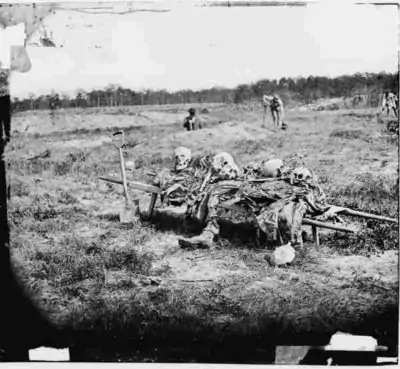Most people think of Appomattox when they think of the last surrender of the Civil War, but it wasn’t. The final surrender was in the Trans-Mississippi Theater on June 2, 1865. It was only the year before that General Lee devised the first Trench Warfare at the bloody battle of Cold Harbor where some 18,000 boys and men died. You can still see some of the trenches.
The Civil War was fought to free the slaves and for States’ Rights. Originally, it was allegedly only to preserve the Union, but it was clear that President Abraham Lincoln wanted the institution of slavery abolished by any means necessary.
There were an estimated 1.5 million casualties, with 620,000 killed, 476,000 wounded, and 400,000 captured and missing.
Most casualties and deaths in the Civil War were the result of non-combat-related diseases. For every three soldiers killed in battle, five more died of disease. The primitive nature of Civil War medicine, both in its intellectual underpinnings and in its practice in the armies, meant that many wounds and illnesses were unnecessarily fatal.
Our modern conception of casualties includes those who have been psychologically damaged by warfare. This distinction did not exist during the Civil War. Soldiers suffering from what we would now recognize as post-traumatic stress disorder were uncatalogued and uncared for.
One in four soldiers who went to war never returned. It is estimated that one in three Southern households lost at least one family member.
JUNE 2ND
June 2, 1865, marks the last Confederate surrender in the Trans-Mississippi Theater.
There were Federal operations against Indians in the vicinity of Crystal Palace Bluff, about Fort Rice, the Dakota Territory, as one man is reported dying from arrow wounds.
On May 26, 1865, Federal commanders accepted the surrender of the last major organized Confederate force still in the field.
Confederate General Edmund Kirby Smith commanded the Trans-Mississippi District, in which the Army of the West was assigned to cover western Louisiana, Missouri, Arkansas, the Indian Territory (now Oklahoma), Texas, and the territories of New Mexico and Arizona. The army had not been much of a fighting force since its failed Missouri incursion last fall, but Smith urged his men to continue resisting nonetheless:
“Show that you are worthy of your position in history. Prove to the world that your hearts have not failed in the hour of disaster and that at the last moment you will sustain the holy cause which has been so gloriously battled for by your brethren east of the Mississippi… The great resources of this department, its vast extent, the numbers, the discipline, and the efficiency of the army, will secure to our country terms that a proud people can accept, and may, under the Providence of God, be the means of checking the triumph of our enemy and securing the final success of our cause.”
In early May, Smith rejected a proposal from Major General John Pope, commanding the Federal Department of the Missouri, to surrender under the same terms that Ulysses S. Grant had given Robert E. Lee, William T. Sherman had given Joseph E. Johnston and E.R.S. Canby had given Richard Taylor. Two days later, Smith reported that most of his 50,000 men had “dissolved all military organization and returned to their homes.”
Nevertheless, Smith continued holding out while other Confederate commanders gave in. Brigadier General M. Jeff Thompson, the “Swamp Fox of the Confederacy” who had harassed Federals in Missouri and Arkansas throughout the war, surrendered the remnants of his brigade at Chalk Bluff, Arkansas. Major General Samuel Jones surrendered his small command in Florida at Tallahassee. And notorious raider William C. Quantrill was mortally wounded in Spencer County, Kentucky, thereby ending most of the guerrilla warfare in the border states.
Finally realizing that Federal numbers might be too overwhelming, Smith called a conference with the exiled governors of Louisiana, Missouri, Arkansas, and Texas at Marshall, Texas, on the 13th. Smith told the attendees that it was his duty to hold out “at least until President Davis reaches this department, or I receive some definite orders from him.” Smith was still unaware that Jefferson Davis had been captured.
The governors disagreed, considering it “useless..” However, Brigadier General Joseph O. “Jo” Shelby, one of Smith’s lieutenants, threatened to arrest his superior if he followed the governors’ advice and surrendered. The men ultimately decided to appoint Louisiana Governor Henry W. Allen to go to Washington to try negotiating a settlement.
Two days later, Smith refused a second overture from Pope to surrender. Pope’s messenger offered Smith a choice between unconditional surrender or “all the horrors of violent subjugation.”
Smith told the man that he could not “purchase a certain degree of immunity from devastation at the expense of the honor of its (the Confederacy’s) army.”
Meanwhile, in Washington, Grant sent Major General Philip Sheridan to destroy what remained of Smith’s army. Sheridan asked to stay in Washington to participate in the Grand Review, but Grant insisted that he leave immediately. Grant explained that not only would Sheridan be forcing Smith’s surrender, but he would also be discouraging France from colonizing Mexico in violation of the Monroe Doctrine. Sheridan’s fearsome reputation for pillage and destruction would surely precede his arrival.
Smith soon received word both that Sheridan was coming and Jefferson Davis had been captured. With his army rapidly disbanding, he decided to finally negotiate.
He dispatched his chief of staff, Lieutenant General Simon B. Buckner, to discuss peace, not with Pope at St. Louis but with Major General E.R.S. Canby at New Orleans. Smith did not expect Buckner to make that decision without consulting him on what terms he could expect.
Buckner and Canby began conferring on the 25th, and the next day Buckner made that decision without consulting Smith.
He surrendered the Confederate Army of the West to Canby’s chief of staff, Major General Peter J. Osterhaus, under the same terms Grant had given Lee. As fate would have it, Buckner had surrendered the first Confederate army at Fort Donelson in 1862, and now he surrendered the last.
Smith arrived in Houston on the 27th and learned that his army had been surrendered the day before.
He refused to endorse the agreement, and on the 30th he issued a final order to his few remaining men in the form of an admonition: “Soldiers! I am left a Commander without an army– a General without troops. You have made your choice. It was unwise and unpatriotic, but it is final. I pray you may not live to regret it.”
Smith finally relented and signed the articles of surrender on June 2, aboard the steamer Fort Jackson at Galveston. Those who refused to give up were paid in gold and mustered out, including Jo Shelby and others hoping to continue the fight from Mexico. Smith himself would join them later.
The surrender of E.K. Smith’s Trans-Mississippi District meant that the last significant Confederate fighting force was no more. Some commanders who led small, less organized units continued holding out, including General Stand Watie. Others just went home, ultimately accepting that the war was over at last.
Information via Civil War Months.
The year before, the Cold Harbor battle was being fought in June as Lee tried to retake the battlefield.
COLD HARBOR BATTLEFIELD, RICHMOND VA
The battlefield is said to be one of the creepiest places on earth. It is where trench warfare was first fought.
Cold Harbor, then and now:

JUNE 1
Lee wished to retake Old Cold Harbor and sent Major General Joseph Kershaw’s division to join Hoke in a morning assault. The effort was short and uncoordinated. Hoke failed to press the attack and Sheridan’s troopers, armed with Spencer repeating carbines, easily repulsed the assault.
Grant, encouraged by this success, ordered up reinforcements and planned his own attack for later the same day. If the Union frontal assault broke through the Confederate defenses, it would place the Union army between Lee and Richmond. After a hot and dusty night march, Major General Horatio Wright’s VI Corps arrived and relieved Sheridan’s cavalry, but Grant had to delay the attack Major General William Smith’s XVIII Corps, Army of the James, marching in the wrong direction under out-of-date orders, had to retrace its route and arrived late in the afternoon.
The Union attack finally began at 5 p.m. Finding a fifty yard gap between Hoke’s and Kershaw’s divisions, Wright’s veterans poured through, capturing part of the Confederate lines. A southern counterattack however, sealed off the break and ended the day’s fighting. Confederate infantry strengthened their lines that night and waited for the battle to begin next morning.
JUNE 2
Disappointed by the failed attack Grant planned another advance for 5 a.m. on June 2. He ordered Major General Winfield Hancock’s II Corps to march to the left of the VI Corps.
Exhausted by a brutal night march over narrow, dusty roads, the II Corps did not arrive until 6:30 a.m. Grant postponed the attack until 5 p.m.
Later that day, he approved a postponement until 4:30 a.m. of June 3 because of the spent condition of Hancock’s men.
The Union delays gave Lee precious hours, time he used to strengthen his defenses. The Confederates had built simple trenches by daybreak of June 2. Under Lee’s personal supervision, these works were expanded and strengthened throughout the day. By nightfall the Confederates occupied an interlocking series of trenches with overlapping fields of fire. Reinforcements under Major General John Breckinridge and Lieutenant General Ambrose Hill arrived and fortified the Confederate right. Lee was ready.
JUNE 3
At 4:30 on the morning of June 3 almost 50,000 Federal troops in the II, VI and XVIII Corps launched a massive assault.
The Confederate position, now well entrenched, proved too strong for the Union troops. In less than an hour, thousands of Federal soldiers lay dead and dying between the lines.
Pinned down by a tremendous volume of Confederate infantry and artillery fire, Grant’s men could neither advance nor retreat. With cups, plates, and bayonets, they dug makeshift trenches. Later, when darkness fell, these trenches were joined and improved.
JUNE 4-12
The great attack at Cold Harbor was over. Hundreds of wounded Federal soldiers remained on the battlefield for four days as Grant and Lee negotiated a cease-fire. Few survived the ordeal.
From June 4 to June 12 both armies fortified their positions and settled into siege warfare. The days were filled with minor attacks, artillery duels and sniping. With the Union defeat at Cold Harbor, Grant changed his overall strategy and abandoned further direct moves against Richmond.
On the night of June 12 Union forces withdrew and marched south towards the James River. During the two week period along the Totopotomoy and at Cold Harbor, the Federal army lost 12,000 killed, wounded, missing, and captured while the Confederates suffered almost 4,000 casualties.
Grant’s next target was Petersburg and the railroads that provided needed supplies to the Confederate army. Cold Harbor proved to be Lee’s last major field victory and changed the course of the war from one of maneuver to one of entrenchment.
Information via the Library of Congress.



